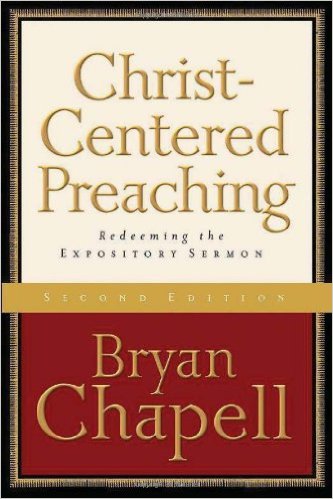Bryan Chapell has written the book Christ-Centered Preaching: Redeeming the Expository Sermon. He received his PhD from Southern Illinois University. He is president and professor of practical theology at Covenant Theological Seminary in St. Louis, Missouri. He has authored many books including Each for the Other and The Promises of Grace. This work is a second edition that was published in 2005; the first edition was published in 1994.
This book is broken down into three sections, the first dealing with principles for expository preaching, the second focusing on the preparation of expository sermons, and the third revealing a theology of Christ-centered messages. The majority of the book is divided up between the first two sections with the third serving to reemphasize the importance of the redemptive approach to preaching as well as give instruction on how to develop such an approach. The major themes that arise from this book is the importance and power of God’s Word, the need of application, and developing a redemptive historical approach to preaching. Many illustrations are given throughout the book serving as examples for the reader to process the information. There are also numerous quotations from great preachers of the past used as support for the principles developed in the book.
In the first section of the book dealing with principles for the expository sermon the power of the Word is addressed. Above all it is argued that the Word does the work. The preacher can take great comfort in knowing that the power of preaching does not reside in his eloquence or charisma. Yet this truth is qualified by the stated importance of the preacher’s witness. Though the ultimate source of power is not the preacher, he is still obligated to be a faithful witness to the truth. In fact, studies show that one of the strongest factors as to whether a person will receive an orator’s message is their perception of his character.
The main obligations of any sermon are discussed in the next chapter. Here the unity of a sermon is revealed to be vital. Yet even more emphasis is given to the purpose of a sermon. The purpose of a sermon is not to simply transfer information but to show people both their sin and God’s grace. To do this well the preacher must discover the Fallen Condition Focus of their text. This is the aspect of their text that reveals an aspect of human sin in preparation to receive God’s empowering grace. A final obligation of any sermon is application. A sermon is meant to move people to action, change, and response. It is here that we see the difference between a sermon and a lecture; mere information transfer will not suffice in the pulpit.
The third chapter directs the reader to the priority of the text. First the selection of a text is addressed. Included in the selection of a passage to preach are some thoughts on the length of a sermon. Here there is also advice on the benefits and dangers of choosing an obscure text rather than a common one. A list of tools is given for the task of interpretation. This list includes lexicons, topical Bibles, dictionaries, and Bible translations. Much space is given to principles for accurate interpretation of a given text in this chapter. The grammatical-historical method is asserted as the best option for biblical interpretation. The need to keep the text in context as well as determine the redemptive flow of the passage is also shown to be necessary to rightly understanding a passage.
The following chapter is the final under the first section of principles for expository preaching and it points to the components of exposition. First it is stated that the goal is not information but application of God’s Word. The pattern to reach this goal consists of presenting God’s Word, explaining it, and exhorting people to believe and obey. The main components are explanation, illustration, and application. To draw this chapter to a close a word concerning the attitude of the preacher is given. The preacher must preach God’s Word as divine authority, and he must do this in a biblical manner with a humble boldness.
The following section addresses the preparation of expository sermons. Here the components of explanation, illustration, and application are addressed. Explanation must be clear and the Word must be referenced so the people see where the preacher’s ideas are coming from. The explanation should not be strongly defended with logic if such a defense is not needed. Illustration is not only for the simple minded but a necessity for every preacher. Illustrations should be vivid and detailed. Application must be clear, personal, and motivated by God’s mercy in Christ. In this section information concerning outlining, introductions, conclusions, and transitions is also addressed.
The final section of the book is a recap of the importance of preaching a redemptive historical sermon. Every text points to Christ yet this should not be forced but arise naturally from the text. To do this the preacher must isolate the FCF of the text and see how God’s grace in Christ addresses human need. Many approaches are given on how to develop a redemptive historical sermon. This can be done in both topical and textual sermons. The preacher must be aware of simply preaching morality and he must study to see how each passage points to the Christ.
In evaluating this work three points come to mind. First, this book focuses strongly on application in preaching, giving solid ground for its necessity. Second, illustrations are not only strongly promoted but much information on delivering relevant ones is given. Thirdly, this book does a good job assisting the preacher to develop redemptive historical sermons through isolating an FCF. This is a solid book and one that is needed in our day with an excellent balance between the two dangers of preaching morality alone and speaking only of Christ severed from the sermon passage.
First this book makes a great case for application in preaching. It addresses the common skepticism of spending significant time in sermon application. The author concedes that the Holy Spirit must compel each person to apply God’s Word, yet this is no reason not to spend time developing and delivering application in the sermon. An excellent case for delivering specific application is made and it is acknowledged that far to many preachers simply give broad sweeping applications that reveal they have not thought enough about the task. This specific application is qualified by identifying the breaking point where congregants will sense the pastor is no longer giving application but truly talking to them. Much of the content in the sections on application are backed up by common sense that reveals the sermon exists to help people draw nearer to Christ and to become more like him. Thus, without application in a sermon it falls short of its designed task.
A very helpful paradigm is put forth to assist the preacher in application. Four questions must be raised about the application and that is What, Where, Why, How? The what deals with the actual instruction given in the application, namely, what is the person to do or believe. The where deals with in what situation they are to do it. The why is important and neglected often, it shows the motivation for the individual to do the instruction. Finally is the how where it is essential to show how God’s power is needed to accomplish this task. This final piece will help the preacher to avoid preaching mere morality.
This book spends significant time defending the use of illustrations. It seems the author does a great job of surveying the common distaste for illustrations and points out that much of this comes from pride. The Old and New Testaments are cited as support for the use of illustrations in teaching and preaching. An important distinction is made in the way many understand illustrations and the clarification is profound. Many understand illustrations to be put forth simply to draw people in and keep them awake, yet this is incorrect. In fact, illustrations are a way in which a truth is taught or further taught. The illustration casts more light on the subject and helps the listener to remember the information. Again here they only support needed is personal experience for everyone can remember a vivid illustrations given in a sermon they have heard.
Finally this book gives abundant support for a redemptive historical approach to preaching a given text. The FCF is littered throughout the book and a very helpful tool for the preacher. This focus on the human condition is the key to unlock God’s grace in passages that are not as directly connected to Christ and his work. A theological defense for this approach is marshaled and very strong for it is clear that we must see the need for God’s grace before we can speak of his grace. Many variations on how to address the redemptive historical focus of different passages are given; this is a very solid resource for preachers.
To conclude, this book is a great resource for any preacher who wants to preach the glories of God in our crucified and risen Savior. It is well balanced with a strong emphasis on application, illustrations, and preaching Christ correctly from God’s Word. Many dangers in tone, character, application, and exegesis are given to help the preacher avoid these traps. The tools given for preaching Christ are clear and will help the preacher greatly.


















